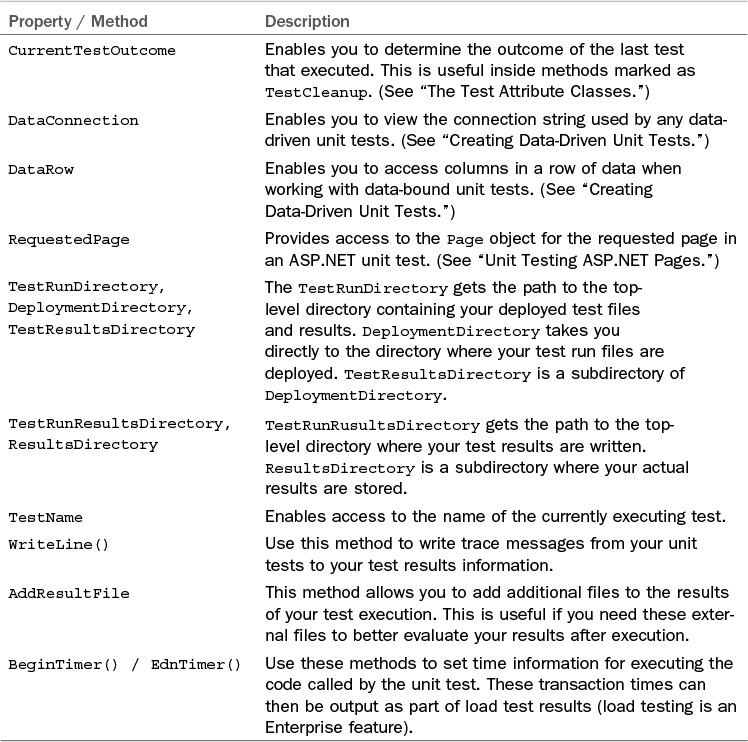 The TestContext Class
by Mike Snell, Lars Powers
Microsoft Visual Studio 2015 Unleashed, Third Edition
The TestContext Class
by Mike Snell, Lars Powers
Microsoft Visual Studio 2015 Unleashed, Third Edition
- About This eBook
- Title Page
- Copyright Page
- Contents at a Glance
- Table of Contents
- About the Authors
- Dedication
- Acknowledgments
- We Want to Hear from You!
- Reader Services
- Introduction
- Part I: Introducing Visual Studio 2015
- Chapter 1. A Quick Tour of Visual Studio 2015
- Chapter 2. The Visual Studio IDE
- Chapter 3. The .NET Languages
- What’s New in C# 6.0 and VB 14
- Language Primer
- Language Features
- Infer a Variable’s Data Type Based on Assignment
- Create an Object and Initialize Its Values (Object Initializers)
- Define a Collection and Initialize Its Values
- Creating an Instance of a Nonexistent Class
- Add Methods to Existing Classes (Extension Methods)
- Add Business Logic to Generated Code (Partial Methods)
- Access and Query Data Using the .NET Languages
- Write Simple Unnamed Functions Within Your Code (Lambda Expressions)
- Splitting an Assembly Across Multiple Files
- Working with XML Directly Within Your Code (VB Only)
- Removing Unused Arguments from Event Handlers (VB Only)
- Creating an Automatically Implemented Property
- Dropping the Underscore in VB for Line Continuation
- Working with Dynamic Languages/Objects
- Covariance and Contravariance
- Asynchronous Programming
- The .NET Framework
- Summary
- Part II: An In-Depth Look at the IDE
- Chapter 4. Solutions and Projects
- Chapter 5. Browsers and Explorers
- Chapter 6. Introducing the Editors and Designers
- Part III: Working with the Visual Studio Tools
- Chapter 7. Working with Visual Studio’s Productivity Aids
- Chapter 8. Testing Code
- Chapter 9. Refactoring Code
- Chapter 10. Debugging Code
- Chapter 11. Deploying Code
- Chapter 12. Developing Applications in the Cloud with Windows Azure
- Chapter 13. Working with Databases
- Part IV: Extending Visual Studio
- Part V: Building Web Applications
- Chapter 17. Building Modern Websites with ASP.NET 5
- Chapter 18. Using JavaScript and Client-Side Frameworks
- Chapter 19. Building and Consuming Services with Web API and WCF
- Part VI: Building Windows Client Apps
- Chapter 20. Building Windows Forms Applications
- Chapter 21. Building WPF Applications
- Chapter 22. Developing Office Business Applications
- Part VII: Creating Mobile Apps
- Chapter 23. Developing Windows Store Applications
- Chapter 24. Creating Windows Phone Applications
- Chapter 25. Writing Cross-Platform Mobile Applications with Apache Cordova
- Index
- Code Snippets
The TestContext Class
The unit test framework contains a class that is used to store information pertaining to executing tests. This class is called TestContext. You use the properties of this class to get information about your running tests, including the path to the test directory, a URL to the executing test (in the case of ASP.NET unit tests), and data-binding information such as the data connection or the current row of data for the executing test class. There are also a couple useful methods of this class for things like writing trace messages. The test context information is stored inside properties of this class. The key properties and methods are defined inside Table 8.1.
TestContext is not accessible to your code by default. You access TestContext by first defining a field and a property named TestContext. The unit test framework automatically creates an instance of a TestContext object when it runs your tests. It then looks for a TestContext property in your source code. If it finds it, the framework assigns an instance of TestContext to your property. You can then use your property to access information about the executing test context. The following code shows how you might define the TestContext property in a C# unit test.
private TestContext testContextInstance;
public TestContext TestContext {
get
{
return testContextInstance;
}
set {
testContextInstance = value;
}
}
Note
Some attribute classes require that you define a parameter of type TestContext to your decorated method. This is true for ClassInitialize (as discussed later). In this case, the unit test framework automatically passes an instance of a TestContext object to your method when it executes.
-
No Comment
